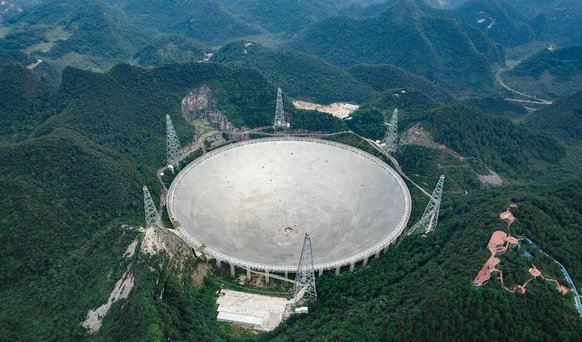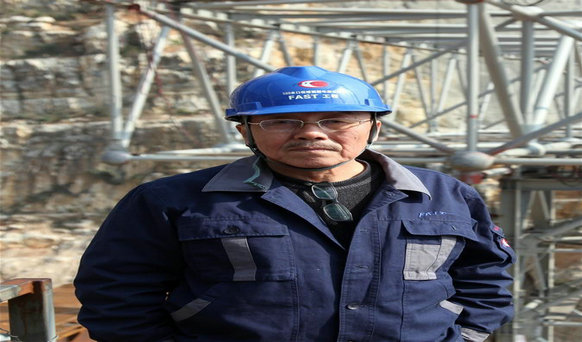China's "eye of heaven" to open the eye of the world

An aerial view of FAST. (Photo /Xinhua)
At first glance, Pingtang county of Guizhou province doesn't look different from any other mountainous regions in Southwest China. In late June, clouds fill the horizon with their melancholy folds, flowers bloom on the grassy marshland with cuckoos and cicadas never ceasing to end. Everything looks sleepy in the summer heat.
A few meters away, however, a gigantic silver hemispherical "cauldron" surrounded by rolling hills that nicely conceal this amazing structure suddenly appears.
This cauldron is the Five-hundred-meter Aperture Spherical Radio Telescope, the world's largest filled-aperture and most sensitive radio telescope. FAST has an imaginative Chinese name, Tian Yan, which means the "Eye of Heaven". Just as its name suggests, FAST will not only help mankind to explore the universe for neutral hydrogen, detect pulsars but possibly answer some unknowns in the interplanetary space.
It took five years from the excavation of the site to the final completion in September 2016. But the vision of building a giant telescope in China can be traced back to 1990s. Since then, Chinese astronomical scientists have started the preparation work with an unprecedented path waiting for exploration.

Nan Rendong, chief scientist of FAST. (Photo /Xinhua)
"I am not a master of strategies, just a veteran with knowhows," said Nan Rendong, the founder and chief scientist of FAST, at that time.
It was Nan who led the whole team through the long slog. Countless difficulties occurred along the way, but these Chinese scientists never thought of surrender. "When we come to hill, we cut a road; when the river is ahead, we build a bridge," said Jiang Peng, who took over this cause as the chief engineer after Nan passed away at 72 because of lung cancer.
Underpinned by such faith, 22 years later, FAST, which is the size of 30 soccer fields and consists of 4,450 reflecting units and 6,670 steel cables, has finally come into being. Taking advantage of the karst landform of Guizhou province, scientists have designed the telescope with a paraboloid surface that maximizes reflection.
"The paraboloid helps with the focus and thus enables FAST to work more efficiently," said Zhao Baoqing, head of the on-site office of FAST.
"FAST could discover ca.150 pulsars a year, while other radio telescopes altogether could detect 50."

Jiang Peng (center), FAST's chief engineer, introduces FAST to students from Tsinghua University. (Photo by Luo Wangshu/chinadaily.com.cn)
Boundless vision, sharing mind
On March 31 this year, after endless trials, the FAST team announced that it would be open to the global scientific community and that any research organization or individual with a need for the project could apply for observation.
"Once the application was issued, foreign astronomical research teams which used to be limited by their geographical location and technical conditions have submitted applications to China," said Jiang.
According to Jiang, the application was accessible from the end of March to mid-May, and "more than 200 requests have been received so far, among which more than 30 came from abroad."
All the submission will be evaluated by top experts in their respective domains to ensure that the approved ones are in line with astronomical frontiers.
The chosen teams are expected to start using FAST in August this year.
From being initially questioned both at home and abroad, to being taken seriously by the astronomical community worldwide, FAST has witnessed the rapid development of China's cutting-edge technology and infrastructure construction.
"In the past, we were often the ones being helped by other countries. Now, the world will benefit from China's leading FAST project," he said.
Astronomic researches don't remain within the borders of the countries where they occur - knowledge is a public good, with little regard for national boundaries. Exploration of the stars has long been an eternal dream.
Exploration in the cosmos is not only related to mankind itself, but also closely associated with the fate of the planet. The space environment has a profound impact on the climate change and biological survival, which is a matter of concern for all mankind.
Chinese government attaches great importance to the construction and development of FAST.
"The opening of FAST can provide China's own contributions and experiences to build a shared community in outer space, and is an important step towards a wider world for the human being," Jiang said.
To date, China has been the "eye-opener" by building FAST, extending human wisdom to distant places that were once unimaginable, and transmitting the unfading hope from this generation to the next. (China Daily)
Wang Yuhuan and Xie Kaifan from Tsinghua University contributed to this story.